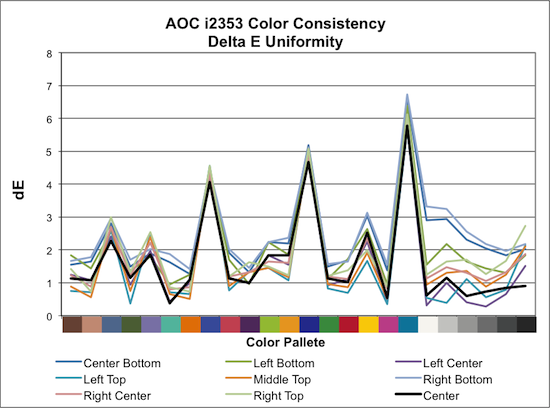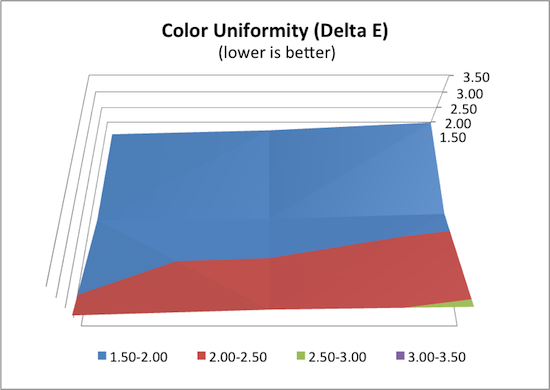AOC i2353Ph - IPS for a nice, low price
by Chris Heinonen on January 30, 2012 12:40 AM ESTUniformity and Contrast
The dE numbers for the AOC have looked good so far, but all of those are for the center of the screen, where backlighting should be the most even and the image should be at its best. To make sure the monitor will give a good overall experience, we also take a set of 9 measurements across the screen using the Gretag Macbeth color chart and see how it does.



The color uniformity across the monitor is surprisingly very good, with very little deviation across any of the colors. The grayscale doesn’t perform quite as well, with the center having an average dE below 1, but a couple other measurements hovering in the range of 2-3 dE. Even the two worst locations still maintained an average dE of 2.55 or less, and the majority of all the results were below 2.0 dE. Overall it has very uniform color across the display.
Since LCD panels are all lit by their backlight to provide color, any errors across the screen can often be traced back to a backlighting system that is uneven and causing those color shifts. As we look at the brightness level across the display when the center is set for 200 nits, we see the drop-off at the bottom of the screen. If the LCD panel itself is behaving the same no matter the location on the screen, the different amounts of light can easily cause the shifts in color that we saw in the last test. Here the locations that had the worst dE uniformity also have the worst brightness uniformity, which is likely the root of the problem.

Once we have found the issues with the brightness, we check to see how well the backlighting system handles darkness across the display. With the AOC there seems to be significant light leakage in the corners of the display, with black levels that are very, very high for the display. I’ve recently seen LED backlit models with good control of the backlight that can get down to very low black levels, but the black levels in the AOC remain high. Some of this is due to the IPS panel, which typically has higher black levels than other panel types. It also could be an area where corners had to be cut to make the aggressive price point that AOC targeted. Regardless of why, the absolute black level is not going to please people that are adamant about deep, dark blacks.











71 Comments
View All Comments
VoraciousGorak - Monday, January 30, 2012 - link
My 6ms Dell 2407WFP has not only been perfectly adequate for games of any kind, I've never noticed it ghost. Ever. And I'm sensitive enough to monitor weirdness that SLI microstutter pisses me off.james.jwb - Monday, January 30, 2012 - link
I had one of these and I noticed some ghosting, but the main problem with them was input lag. You really want a screen with no more than 15ms input lag to be rid of issues. If you put a u2412m side by side with a 2407 and duplicate the desktop, you'd notice it simply by moving the mouse.The old S-PVA screens never really got input lag down to acceptable levels.
JarredWalton - Monday, January 30, 2012 - link
I've still got a 2408WFP sitting around my place, and I can definitely agree that processing lag is too high. Even my wife -- a non-techie user -- noticed it when I recently switched her to that display from an IPS panel. She thought the problem was the mouse, so I switched mice and the problem was still there. If you only ever use an S-PVA display, you may not notice what you're missing, but once you have a better reference point it becomes immediately clear that there are delays on the S-PVA panels. That said, I've never had issues with the <20ms lag; it's only when you start getting above that where it becomes noticeable (for me).JonnyDough - Monday, January 30, 2012 - link
Agreed. Input lag is also a problem. Many gamers don't seem to notice these things, but I certainly do. Maybe we were just spoiled with CRT monitors from back in the day?Sabresiberian - Monday, January 30, 2012 - link
He did.The fact is, most people wouldn't be effected by this much lag, even in FPS gaming.
That being said, if you don't pay attention to the lag from each component of your system it could all add up to something that does effect your performance, so getting a monitor with lower lag can be a plus. However, if you really want lower lag in gaming, I suggest a CRT. Of course if you demand larger than 21" you can't really do that, but then I suggest gaming lag isn't your main concern, if that's the case.
(You also pretty much have to buy used, since they aren't made anymore. However, you can find CRT monitors with better quality than LCDs for less money.)
;)
Zingam - Tuesday, January 31, 2012 - link
TN monitors are crap! I have one low end IPS display and I love it. It is perfect even for games! Oh, yeah, and I connect it to a laptop with ordinary TN display and do you know what? I hate looking at the laptop because of its crappy TN display!TN sucks! That's it! Get over it, losers!
MadAd - Wednesday, February 1, 2012 - link
Im waiting to replace my current IPS, but I wont take TN either.Why no display port too? Or 1200 lines? I want something to drop in the middle of my other 2 24" displays, so i can drive them in a big desktop, having one at 1080 is going to mess it all up.
Seems ill be waiting a long time.
eezip - Monday, January 30, 2012 - link
In the last row of the table on page 1, should the price check be 1/24/2012, instead of 2011?cheinonen - Monday, January 30, 2012 - link
Sorry, fixed!demonbug - Monday, January 30, 2012 - link
On the power use chart, do the Apple Cinema Display and Dell U3011 really use more power at min. brightness than at max, or did they just get their numbers reversed?